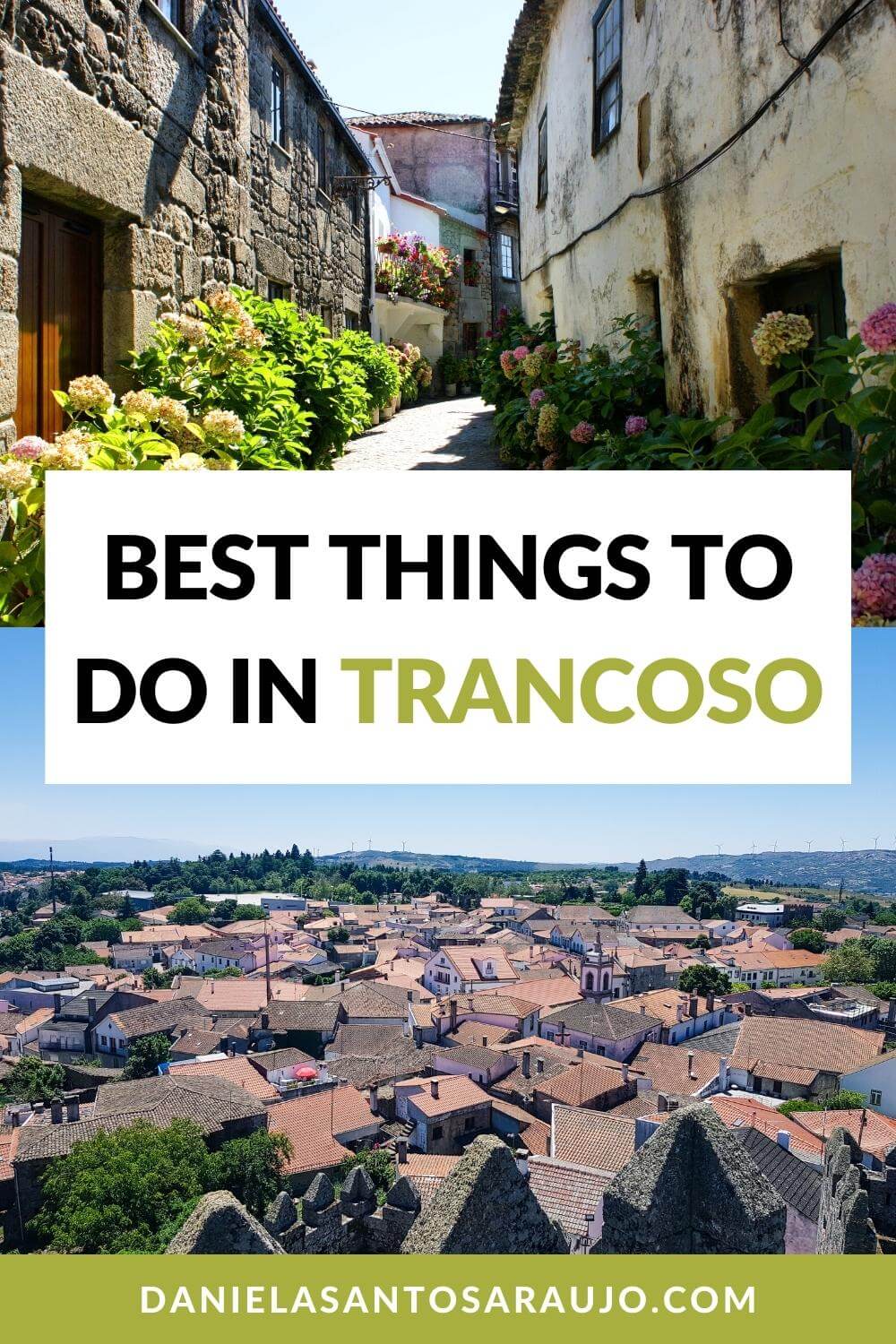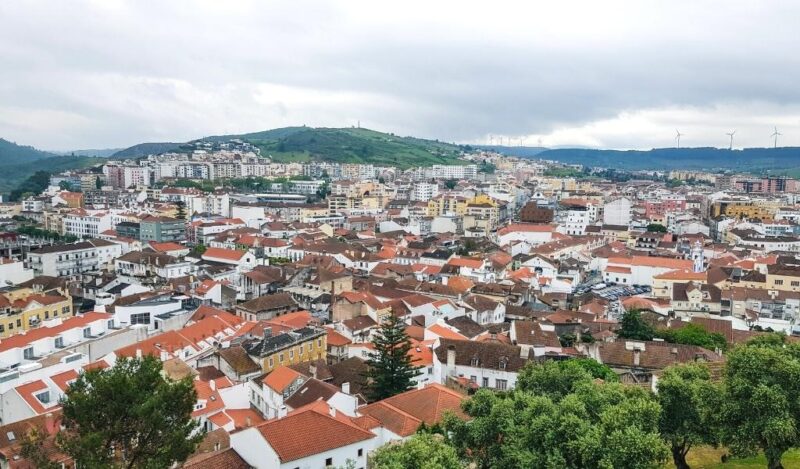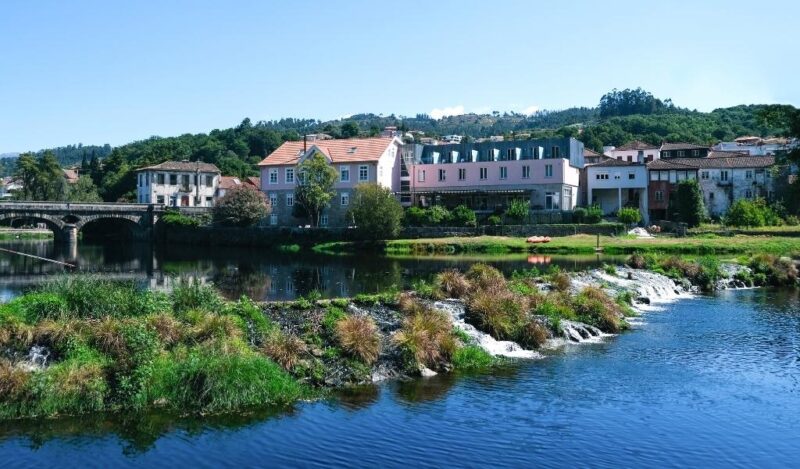Trancoso is a city located in the Guarda district and, simultaneously, one of the “12 Historical Villages of Portugal” (a program created by the Portuguese government in 1991, to restore and enhance a series of villages in the Beira Interior region, older than the country itself).
Nowadays, the historic center of Trancoso is still protected by a walled enclosure, which was built in the Middle Ages. And one of the most important monuments of this period is its Castle, an imposing medieval fortification with privileged views over the lands of Riba-Côa!
So, do you want to know more about 1 Day In Trancoso: The Perfect Trancoso Itinerary? Keep reading!
This post may contain affiliate links, meaning I earn a small commission if you make a purchase, at no additional cost to you. Please read my disclosure & privacy policy for more information.
No time to read now? Pin it for later!


Brief History of Trancoso
Trancoso’s origins date back to the 8th-9th centuries when its castle was founded by the Muslims. And like other historical villages, Trancoso is very close to the Spanish border. Therefore, it was a strategic place for the Kingdom of Portugal during the Christian Reconquista and in the confrontations with the Kingdoms of Leon and Castile.
As a village, Trancoso received the Charter at the beginning of the 1160s, by King Afonso Henriques (the first king of Portugal). As early as 1273, King Afonso III created a free trade fair in the town, transforming Trancoso into a very popular market destination in the region and in the country. Interestingly, this free fair is still celebrated every year in the month of August, under the name of Saint Bartholomew’s Fair!

In the History of Portugal, Trancoso is also known as the place where King Denis married Queen Elizabeth of Aragon (better known as Queen Saint Elizabeth) in 1282. Due to this marriage, the wall was expanded and several buildings were built and renovated within it, leading to the consequent growth of the town.
In 1510, King Manuel I assigned a New Charter to Trancoso and continued the urban redevelopment started by his ancestors. However, its population was persecuted by the General Council of the Holy Office (ie, the Inquisition), as it housed a large Jewish community. In the following centuries, Trancoso lost its importance in the military context, but it recovered its function of defending the national border, during the French Invasions at the beginning of the 19th century.
Visiting Trancoso
On the day I went to Trancoso, I took the opportunity to visit two other historical villages: Marialva and Linhares da Beira (which are about 25 km and 40 km away, respectively). Of course, this is only possible if you have a car, as Trancoso has many points of interest to discover!
Honestly, some of the 12 Historical Villages of Portugal can be visited in one morning or afternoon, as is the case of Castelo Mendo, Idanha-a-Velha, Linhares da Beira, Marialva, Piódão, or Sortelha. As for the others, it depends on the number of monuments you want to include in your itinerary.
Since Almeida, Belmonte, Castelo Novo, Castelo Rodrigo, and Monsanto are towns, it’s likely that you’ll need a day (or two) to explore them from one end to the other. And the same happens with Trancoso, which is a city. By the way, here’s the list of the 12 Historical Villages of Portugal:
- Almeida, in the Guarda district
- Belmonte, in the Castelo Branco district
- Castelo Mendo, in the Guarda district
- Castelo Novo, in the Castelo Branco district
- Castelo Rodrigo, in the Guarda district
- Idanha-a-Velha, in the Castelo Branco district
- Linhares da Beira (or simply Linhares), in the Guarda district
- Marialva, in the Guarda district
- Monsanto, in the Castelo Branco district
- Piódão, in the Coimbra district
- Sortelha, in the Guarda district
- Trancoso, in the Guarda district
Trancoso Itinerary
Saint Bartholomew’s Chapel
If you want to park in the Trancoso Municipal Park area, the first point of interest you’ll find is Saint Bartholomew’s Chapel. Erected at the end of the 18th century, this small Catholic temple incorporates various typical late Baroque decorative elements.
But the most curious detail of Saint Bartholomew’s Chapel is found on the outside wall on the left side! It’s a tile panel created in the mid-twentieth century by the historic Factory Faience Battistini of Maria de Portugal.
Here, it can be read: “In memory of the marriage of King Diniz to Queen Saint Elizabeth of Aragon, held in this town in 1282, this chapel was ordered to be built in 1778 by the City Council of the Municipality.

King’s Gates
As I mentioned in the introduction, the city of Trancoso still conserves much of its walled enclosure, built between the 12th and 14th centuries. And where there are walls, there are towers and town gates! Of the four main doors that existed at this time, you can still visit three: the King’s Gates, the Meadow Gates, and the Oak Tree Gates.

Due to its name and the robustness of its two towers, it’s easy to see that the King’s Gates were the most important entrance to the ancient town. On top of that, it’s known that the road to Coimbra and Lisbon passed here. Therefore, historians assume that it was through these doors that the kings and their court passed, after arriving in their carriages.
City Hall & Bandarra Statue

The City Hall building (or Town Hall) was built in neo-Romanesque style, between 1916 and 1920.
But the Municipality Square is part of this guide on the best things to do in Trancoso due to an even more interesting monument: the Bandarra Statue.
Gonçalo Annes Bandarra was a shoemaker, poet, and prophet, who lived in the first half of the 16th century.
Born in Trancoso, Bandarra became famous for writing messianic pieces based on the Old Testament, leading to him being accused and prosecuted by the Portuguese Inquisition!
Misericórdia Church
The Misericórdia Church dates back to the 18th century, more than two centuries after the foundation of the Santa Casa da Misericórdia in Trancoso.
Due to the time at which it was built, it has late Baroque architecture, with many similarities to Saint Bartholomew’s Chapel.
Even so, its interior includes neoclassical elements, such as the main altar.
Located at the end of Corredoura Street (which starts at the King’s Gates), it has two entrances: the one you see in the photo and the other facing Pillory Square.

Pillory & Saint Peter’s Church
Pillory Square concentrates some of the best things to do in Trancoso. Among them, I recommend climbing the steps of the Pillory (and enjoying the views of the nearby King Dinis Square), exploring Saint Peter’s Church, and passing the porticoes of the Porch House and the Arches House, just to start!

The Pillory dates back to 1510, the year in which Trancoso received the Charter from King Manuel I. For this reason, it has a cage crowned by an armillary sphere and by the Cross of the Order of Christ, the symbols of this monarch. As was a tradition at that time, the Pillory was installed in a central square of the town, in front of Saint Peter’s Church.
Saint Peter’s Church was built in the 18th century, where a medieval church with the same name already existed. As you can see, almost all Catholic temples in Trancoso have been redesigned in the Late Baroque! Inside, Saint Peter’s Church houses the Tomb of Bandarra.
House of the Black Cat

The House of the Black Cat is also known as the House of the Lion of Judah.
The historic building is an important testimony to the Jewish heritage of Trancoso and the origin of the carved figures on its facade is still debated today!
The one seen on the left in this photograph appears to represent the Lion of Judah (a symbol of the Tribe of Judah, one of the tribes of Israel).
As for the other two, no one knows very well! One of them resembles a human head, while the other resembles an animal…
If I had to guess, I’d say it’s a penguin!
Master’s Well
Trying to find the various fountains scattered throughout the historic center is one of the best things to do in Trancoso, especially if you like to appreciate different architectural styles.
The Master’s Well has an unusual name, which can be explained by its location.
This fountain is very close to the House of the Black Cat and the place where there was an old synagogue!
For this reason, it’s likely that the well supplied the mikveh (a space for purification baths) and its name refers to the rabbi of the Jewish community in Trancoso.

Bandarra’s House

Bandorra’s House is a museum dedicated to Gonçalo Annes Bandarra, the famous poet from Trancoso.
Here, it’s possible to discover a small exhibition about the life and work of Bandarra, including the phase in which the artist was persecuted by the General Council of the Holy Office and the legacy that inspired his contemporaries’ writers and poets.
Bandarra’s House is open every day from 9:30 am to 1 pm and from 2:30 pm to 6 pm (in summer) or from 9 am to 12:30 pm and from 2 pm to 5:30 pm (in the winter).
If you have time, take the opportunity to explore the Isaac Cardoso Jewish Culture Interpretation Center, located in front of this house museum (the opening hours are the same). Visiting either two is one of the best things to do in Trancoso!
Castle
Trancoso Castle is the most visited attraction in this city and historical village of Portugal. Listed as a National Monument in 1921, it’s a robust military fortress, comprising a Keep (in the first photo), five rectangular turrets, and the ruins of an old chapel (in the second photo).


The Keep is an impressively wide structure dating back to the period of Muslim occupation (9th-11th centuries). For this reason, it is one of the oldest elements of the Trancoso Castle. Through a modern structure that has been added to the Keep, you can go up to its terrace and enjoy the panoramic views.


The Trancoso Castle is open every day, from 9 am to 12:30 pm and from 2 pm to 5:30 pm, with the last entry being 15 minutes before closing. On public holidays, it’s also possible to visit this monument, except on January 1st, Easter Sunday, May 1st, November 1st, December 24th, and 25th, and on the afternoon of December 31st.
Necropolis of Rupestrian Graves
Outside the walled enclosure and a few meters from the Court of Trancoso, there’s an extensive Necropolis of Rupestrian Graves, with more than thirty tombs carved into the rock. This Necropolis is inescapable proof of Trancoso’s past before it became a city, town, or village!

According to archaeologists, these dozens of anthropomorphic graves were designed by the Visigoths, who inhabited the Iberian Peninsula before the Muslim invasion. However, they date from the 7th to the 12th century, which means that the site continued to be used as a cemetery during the Christian Reconquista.
Meadow Gates
The Meadow Gates were (and still are) the second most important entrance to the historic center of Trancoso after the King’s Gates. By the way, in addition to the four main entrances I mentioned earlier, the medieval wall had two secondary doors – the Traitor’s Gates and the Olhinho do Sol Gates.

Just like the King’s Gates, the Meadow Gates still retains its two imposing square towers and its name is an allusion to a wide meadow that once existed in this place. It’s also known that here started the road to Viseu and Lamego.
Ducal Palace
The last stop on this Trancoso itinerary is the Ducal Palace, also called the Costas, Lopes, and Tavares Manor House.
Although currently in ruins, this building is one of the most stunning in the historical village of Trancoso. It was built in the 18th century in the middle of the late Baroque, like so many other monuments in the historic center.
A curious detail is the fact that it’s known as the “Ducal Palace”, even though it has never been the residence of princes or members of the Portuguese Royal Family. Even so, it belonged to the Costa, Lopes, and Tavares families, among which its first owner stands out: Jacinto Lopes da Costa Tavares, Governor of Arms of the Beira.

Map of the Trancoso Itinerary
Share this blog post on your social media!
More Posts about Portugal
4 Best Monasteries In Portugal (That You Should Visit This Year)
5 Best Palaces In Sintra (That You Should Visit This Year)
1 Day In Penafiel: The Perfect Penafiel Itinerary
More Posts about Travel Itineraries
1 Day In Penafiel: The Perfect Penafiel Itinerary
1 Day In Torres Vedras: The Perfect Torres Vedras Itinerary
2 Days In Arcos De Valdevez: The Perfect Arcos De Valdevez Itinerary
What Photography Gear Do I Use?
- Camera Body: Fujifilm X-T4 Mirrorless
- Camera Lens: Fujinon XF 18-55 mm F2.8-4 R LM OIS
- Tripod: Manfrotto Compact Action
- Small Tripod: Manfrotto PIXI Mini
- Smartphone Adaptor: Manfrotto PIXI Clamp
- Memory Card: SanDisk 128GB Extreme PRO SDXC





